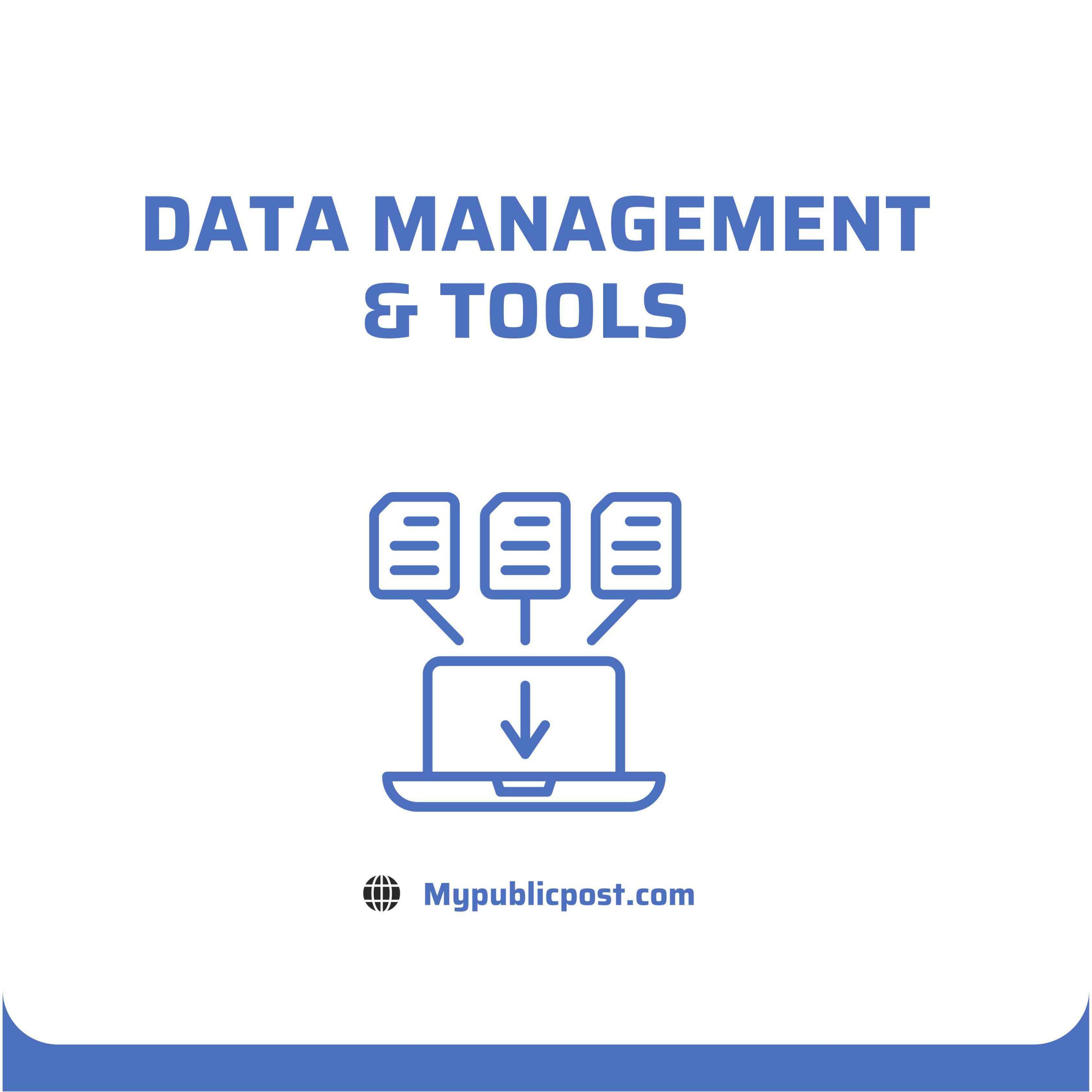Data management is vital in today’s digital world, transforming data into valuable organizational assets. This guide explores key concepts, tools, and the benefits of effective data management.
Key Takeaways:
- Data Management Definition: Process of collecting, processing, storing, and safeguarding data.
- Fundamental Areas: Data governance, integration, quality management, security, and storage.
- Types of Data Management: Operational, analytical, metadata, master data, and big data management.
- Challenges: Data complexity, security, quality, governance, and scalability.
- Importance: Enhances decision-making, operational efficiency, compliance, customer experience, and innovation.
- Tools: Data integration, quality tools, MDM tools, data security software, and DBMS.
Indeed, it is widely known that in the world that is currently being defined as the digital world, data plays a significant role as an important asset for organizations in various industries. Data is a valuable asset in today’s organizations, and, thus, managing this asset for organizational benefit requires proper coordination and attention particularly in making the right organizational decisions and meeting the legal requirements. In this guide, we establish the general concepts of DM, the relevance of the tools, and their application in contemporary enterprises.
Understanding Data Management
It can be defined as the process of collection, processing, storage, and safeguarding of data starting from its generation to its disposal. It comprises a set of processes and measures aimed at the maintenance of appropriate data quality, as well as their availability and protection to achieve the predefined objectives and implement various strategic plans. Proper data management enables an entity to derive value from data, increase operational productivity, and sustain competitiveness in a world that is already saturated with information.
Fundamental Areas of Data Management
Data management comprises several interconnected components that work together to manage data effectively: Data management comprises several interconnected components that work together to manage data effectively:
1. Data Governance
As mentioned earlier, data governance entails the development of policies, roles, and responsibilities concerning the general management of data resources in an organization. It establishes the rules for data utilization, protection, and correctness to ensure that the data are credible and compliant to the acting laws. Key aspects of data governance include: Key aspects of data governance include:
Policy Development: Developing regulations on how the data should be utilized and safeguarded at every stage of its use.
Data Stewardship: Mandatory for the stakeholders, it involves the identification of individuals or work teams that should monitor the quality of data, their use, and compliance with governance rules.
Compliance Management: Overseeing that data handling procedures are compatible with the current legal guidelines and standards (GDPR, HIPAA, or any other regional/national rules and policies).
2. Data Integration
It means the process of integrating different types of data on the organizational level to have a better vision of data representation while making decisions. The purpose of the master is to reduce data duplication and disparities to improve ways through which data is shared and managed across different systems and repositories. Key aspects of data integration include: Key aspects of data integration include:
Data Extraction: Collecting data from databases, and applications internal to the organization and different external systems.
Data Transformation: Adapting and normalizing data to make them compatible and homogenous so that they can be easily processed by the intermediaries.
Data Loading: Transferring pre-processed data from various sources to a place where they get stored and then analyzed.
3. Data Quality Management
Data quality management aims at maintaining quality data, particularly accuracy, consistency, and completeness to support decision-makers as well as improve an organization’s operations. It includes methods and techniques relevant to the detection of errors and the provision of solutions for their elimination. Key aspects of data quality management include: Key aspects of data quality management include:
Data Profiling: Cleansing the data by checking for the quality of data by eliminating unreliable data such as outliers, duplicates and values that are missing.
Data Cleansing: Data cleaning that involves the process of eliminating old and irrelevant data and adding the missing or complete data.
Data Validation: The process of confirming data’s compliance with the identified quality characteristics and business rules.
4. Data Security
The concept of data protection means actions or plans that aim at the safety of data from access, attack, and cybercrimes. It incorporates the process of using security controls, means of encrypting information as well as methods of accessing the various data assets within an organization. Key aspects of data security include: Key aspects of data security include:
Access Control: Intercepting and controlling the access to data using the roles, privileges, and authentication mechanisms.
Data Encryption: Secure transmission of information implying data encryption before it is stored and while it is being transferred from one point to another.
Data Monitoring: The timely identification and mitigation of security breaches, which is possible only when there is constant vigilance over the kind of data being accessed and used.
5. Data Storage and Retrieval
Data storage and retrieval deal with how data is stored in secure, large repositories for subsequent, quick, and easy access when required for analysis, reporting, or other business purposes. This includes choosing of right type of storage sub-system, the right type of storage media, and access speed, and right type of data protection, and the right type of backup. Key aspects of data storage and retrieval include: Key aspects of data storage and retrieval include:
Storage Architecture: Creating solutions for data storage (like databases, data lakes, or cloud) that will satisfy the needs in terms of performance, scalability, and costs.
Data Backup and Recovery: Using techniques and measures to effectively conduct the data backup process and data restore processes in the event of data loss or IT system failure.
Data Archiving: WinFS will thereby help in migrating archived or infrequently used data to the Longhorn while still preserving its access for compliance or reference.
Types of Data Management
Data management can be categorized into several types based on its focus and objectives: Data management can be categorized into several types based on its focus and objectives:
Operational Data Management: Concerned with operational datasets, or exacting data utilized for business transactions and regular commerce.
Analytical Data Management: It entails the use of data for reporting and analysis, benchmarking, or business intelligence.
Metadata Management: Oversees the master data, which includes details on data objects how they can be used, and in what form they were obtained.
Master Data Management (MDM): Pertains to the process of maintaining and implementing standard forms of master data in different facets of the organization to guarantee its credibility.
Big Data Management: Handles both structured and unstructured data which are sometimes very massive and need extra tools and techniques for storage and analysis.
Challenges of Data Management
Despite its importance, data management poses several challenges for organizations: Despite its importance, data management poses several challenges for organizations:
Data Complexity: Regarding data types, formats, and source heterogeneity, managing the complexity and implementing proper integration and management solutions becomes challenging.
Data Security: Securing information from an intrusion, unauthorized entry, and cyber threats cannot be over-emphasized especially due to the importance of compliance with relevant data protection laws.
Data Quality: Some of the issues affecting data accuracy, consistency, and completeness are errors while entering the data, chances of duplication, and at times, the data may not be complete.
Data Governance: Setting up the best practices of data governance and implementing regulations to be adhered to within the organization to curb issues of intrapreneur.
Scalability: Big data means high volumes of information, which means this data has to be dealt with, stored, and managed with the help of vast infrastructure, storage systems, and practices.
Importance of Data Management
The processing of data plays a critical role in increasing the efficiency and competitiveness of an organization in the contemporary world. Here are key reasons why data management consulting services is crucial: Here are key reasons why data management is crucial:
1. Decision Making
Information is the power that makes it possible to make the right decisions and credible data act as that power. This way, organizations are provided with accurate and complete data that is constant enough to allow them to acquire insights and trends from the data they have. This helps the stakeholders and the decision makers to be in a position to make their decisions primarily well-informed to allow them to have prepared adequately and timely to arrive at certain market trends and chances.
Data-Driven Insights: Business intelligence helps in presenting accurate patterns, correlations, and market trends into a business, as a means of arriving at strategic business decisions.
Predictive Analytics: Historical and real-time data usage helps in creating a predictive model and estimating something beforehand, which can help in making sound decisions.
2. Operational Efficiency
The process of managing data is linked to various benefits related to receiving better Organization of work and increased productivity. By centralizing data management practices and optimizing workflows, businesses can: By centralizing data management practices and optimizing workflows, businesses can:
Reduce Redundancy: Reduction of time spent in entering data repetitively and authorizing storage as well as access to data.
Enhance Collaboration: Make it easy to share and transfer data between the departments and other teams.
Automate Tasks: The elements of automation should include best practices and processes to automate ways of handling data, reporting, and analysis.
Effective data management not only controls the cost of operations but also provides employees with up-to-date correct data to help them concentrate on the key objectives and added-value endeavors.
3. Compliance
It is also crucial to follow rules and regulations related to data to reduce legal and regulation risks. Effective data management practices ensure: Effective data management practices ensure:
Data Privacy: Secure the customers’ data do not disclose such information without permission and abide by the legislation regarding data protection that exists internationally, nationally or at the state level (e.g., GDPR, CCPA).
Regulatory Compliance: Ensure compliance with the legislative and industry requirements for data management, protection, and reporting.
Audit Readiness: Under the context of audit and regulatory inspections, keep records and documents that support the management and quality of data.
Proper tackling of data governance and compliance helps organizations gain trust from their consumers or clients, avoid legal consequences for noncompliance, and maintain a good brand image in the market.
4. Customer Experience
Understanding the customer as a whole and providing him or her with corresponding customer experiences, thus, remain partly dictated by detailed customer knowledge. Effective data management enables businesses to Effective data management enables businesses to:
Segmentation and Targeting: Organize customers by demographics, buying behaviors, and preferences to better market effectively when it comes to products and special offers.
Customer Insights: The implementation of data analytical tools in organizations will help in the understanding of the customers’ needs and desires, which positively affects the level of satisfaction and brand loyalty customers have towards an organization’s products or services.
Real-Time Responsiveness: Predict the customers’ needs and ensure that the customers receive the right and timely messages/contact/responses based on the updated information.
Using data to improve customers’ experience, companies and organizations can build lasting relationships with their clients, change the overall perception of their brands, and obtain competitive advantages in the market.
5. Innovation
Thus, the efficiency of data management is an essential criterion that contributes to the enhancement of the company’s performance through empowering such key strategies as advanced analytics, machine learning, and artificial intelligence. Organizations can:
Drive Innovation: New ideas can be found for new opportunities, for new products and services that may be of importance in the future based on collected data and market trends.
Optimize Processes: Integrate AI and machine learning solutions to reduce the burden on the staff and administration while enhancing the efficiency of the numerous day-to-day processes, and increase the velocity of improvement.
Harness Big Data: Use the principles of MSDE to find patterns and trends in big data accumulation and utilize them as the basis for innovations.
Thus, the focus on building an innovative culture based on the use of data can help organizations consistently monitor new trends in competition and increase the pace of change, adapt to new technologies, and use them to generate revenue and maintain profitability.
Data Management Tools: Improving Efficiency & Effectiveness
Data management solutions are to be understood as programs for the management of data processes. These tools provide features that help in data acquisition, data processing data analysis, and data presentation. Here are some commonly used data management tools: Here are some commonly used data management tools:
1. Data Integration Tools
A data integration tool is a type of tool that makes it easier to extract data from different sources and put them into a common format. They include Informatica PowerCenter, Talend, and Apache NiFi through which data can be transferred from one system or platform to another.
2. Data Quality Tools
Data quality tools enable organizations to have correct, standard, and whole data when quality issues of the data are detected and corrected. Other tools conform to the IBM InfoSphere Information Analyzer, the Talend Data Quality, as well as the Trillium Software as they will aid in profiling, cleansing, and monitoring.
3. It is important to note that many organizations implementing a Master data Management program leverage MDM tools.
Master Data Management tools are used for the administration and regulation of master data subjects within different areas of an organization. Some examples of Master Data Managements tool include IBM MDM, Informatica MDM, and SAP Master Data Governance which consolidate and ensure consistency of key data resources.
4. Business Data Security Software and Governance Solutions
The protection of data is maintained with these tools by setting up policies, access controls, and compliance with the laws. This is made possible by solutions like Varonis Data Security Platform, Symantec Data Loss Prevention, and Collibra Data Governance.
5. Data Storage and Database Management System (DBMS)
Some of the DBMS solutions include the Oracle Database, Microsoft SQL Server, and MySQL; these databases are used to store, organize, and manipulate structured data. They offer ways for obtaining and storing large amounts of data as well as options for making it fast and secure.
Conclusion
To sum it up, data management is critical for organizations to realize the value of the data resources it own and achieve business goals. With proper strategies of data control and employing superior elements of data management, data can be safeguarded, and organizational decisions can be made precise, organizational processes refined, and organizations can meet all the regulatory needs for data management in a world that is turning into a digital world.





